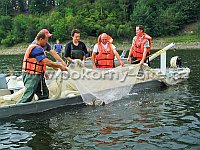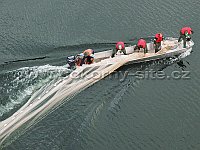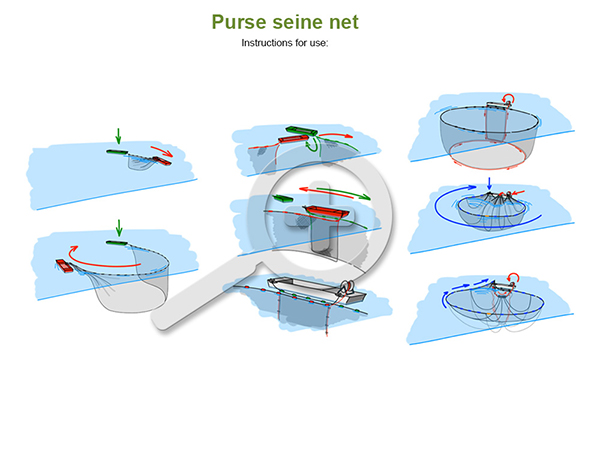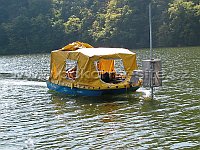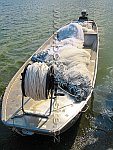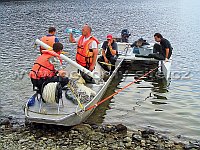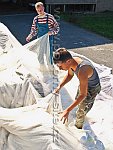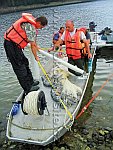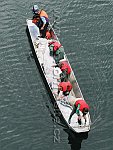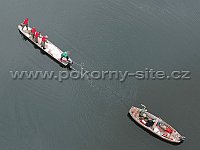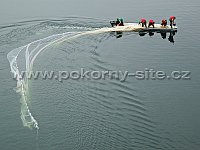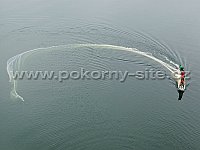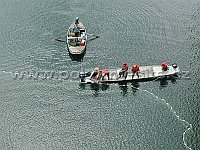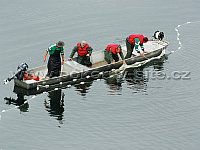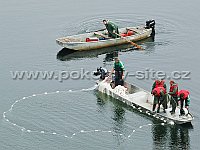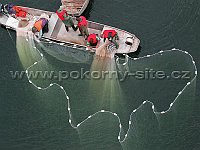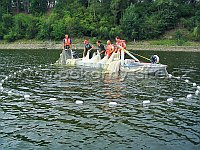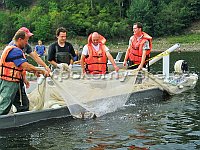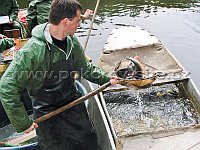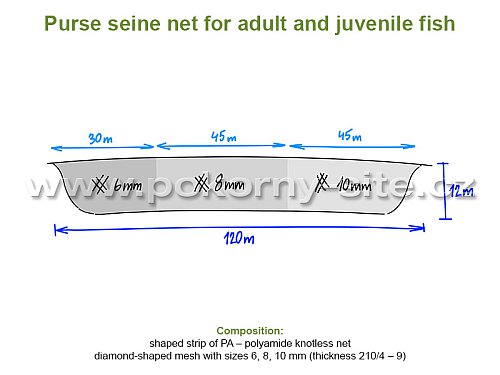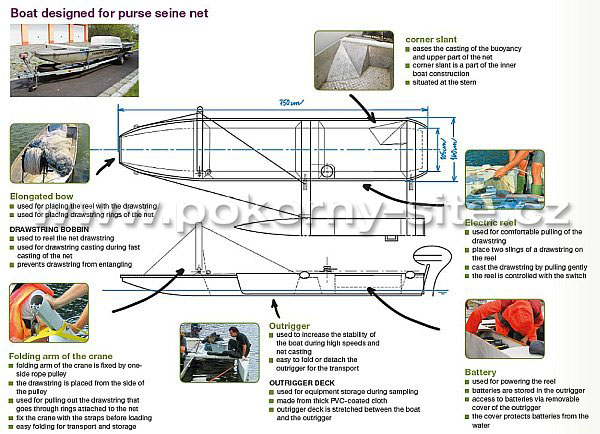Fishing nets - Active fishing gear
Purse seine net
Sampling with purse seine net is based on encircling fi sh in the open water and capturing them.
Usage:
- sampling in open water
- sampling all fi sh sizes
- whole sampling takes place in open water, net is not dragged to the shore
Six rules for successful sampling:
- adequate fi sh presence in sampled area
- net of appropriate size
- net correctly folded in the boat
- fast speed during net casting
- net correctly closes the encircled space
- quick tightening of drawstring
Advantages of purse seine net:
- flexible use
- possible to catch fi sh shoal found by acoustics anywhere in the open water
- high efficiency
- easy to use - short initial training
- possible to gain complex experience
Profile
display / hide whole profile
RNDr. Jiří Peterka, Ph.D. (*1975)
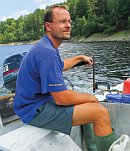 I obtained my doctorate in zoology from the Faculty of Science at the University of South Bohemia in České Budějovice. I worked as a research assistant at the Institute of Hydrobiology (Biology Centre AS CR, v.v.i., Fish Ecology Unit) during my studies. Since 2013 I have been the head of the Department of Fish and Zooplankton Ecology. I am also a council member of the institute of Hydrobiology. My main research topics are succession of fi sh communities in post-mining lakes, research of intra- and inter-specifi c competition (especially competition of our most important families – Cyprinidae and Percidae) and occurrence and behavior of fi sh in open water habitats. I use direct observation techniques and verify their results using active and passive sampling methods. I teach Marine biology and Marine biology field course at the Faculty of Science. I am also supervisor of bachelor, diploma and doctoral theses. I am an author or co-author of more than 30 primary research articles published in a variety of notable scientific journals, treatises, reports and chapters in the professional literature.
I obtained my doctorate in zoology from the Faculty of Science at the University of South Bohemia in České Budějovice. I worked as a research assistant at the Institute of Hydrobiology (Biology Centre AS CR, v.v.i., Fish Ecology Unit) during my studies. Since 2013 I have been the head of the Department of Fish and Zooplankton Ecology. I am also a council member of the institute of Hydrobiology. My main research topics are succession of fi sh communities in post-mining lakes, research of intra- and inter-specifi c competition (especially competition of our most important families – Cyprinidae and Percidae) and occurrence and behavior of fi sh in open water habitats. I use direct observation techniques and verify their results using active and passive sampling methods. I teach Marine biology and Marine biology field course at the Faculty of Science. I am also supervisor of bachelor, diploma and doctoral theses. I am an author or co-author of more than 30 primary research articles published in a variety of notable scientific journals, treatises, reports and chapters in the professional literature.
j.peterka@yahoo.com
tel.: +420 387 775 854
http://www.fi shecu.cz/staff-members/peterka/
Sampling with purse seine net is used mostly in marine fi sheries. The following studies show the possibilities of purse seine net use in lentic waters (Tischler et al. 2000, Ríha et al. 2012, Muška et al. 2013).
References:
Tischler, G., Gassner, H. & Wanzenböck, J. 2000. Sampling characteristics of two methods for capturing age-0 fish in pelagic lake habitats. Journal of Fish Biology 57: 1474-1487
Říha M., Jůza T., Prchalová M., Mrkvička T., Čech M., Draštík V., Muška M., Kratochvíl M., Peterka J., Tušer M., Vašek M., Kubečka J. 2012. The size selectivity of the main body of a sampling pelagic pair trawl in freshwater reservoirs during the night. Fisheries Research 127– 128. 56– 60
Muška M., Tušer M., Frouzová J., Draštík V., Čech M., Jůza T., Kratochvíl M., Mrkvička T., Peterka J., Prchalová M., Říha M., Vašek M., Kubečka J. (2013). To migrate, or not to migrate: partial diel horizontal migration of fish in a temperate freshwater reservoir. Hydrobiologia 707: 17-28.
Instructions for use:
Choosing the right sampling spot
- suffi cient depth in sampled area
- sampled area should be without any fi xed or fl oating structures
- fish should be present – find fish with echo sounder
- sampling for scientific research should be conducted in representative locations and follow a proper sampling design
Boat preparation
- suitable boat – the best choice is a type AKV 001/10 boat developed by members of FishEcU
- boat characteristics – narrow, stable, sufficiently spacious and load-bearing
- the boat should be without projections, fl ashes, knots, floats, or clutter on the bottom (branches, stones etc.)
- the engine should be suffi ciently strong and properly mounted to the boat
Net preparation
- clean the net of all litter (grass, branches etc.), sew all holes in the net
- coil the colored drawstring threaded through rings up at the bow
- place the drawstring with drawstring rings on the lower line at the bow
- coil buoyancy line at the stern
- fold the net core between the buoyancy and lead lines
- net is folded simultaneously with buoyancy and lead lines
- the net end which was folded last goes into the water first. this part has the smallest mesh – 6 mm.
Casting purse seine net
- anchor on a suitable place using the anchor rope (cast the anchor / use an auxiliary boat)
- the net is casted at fast speed by the auxiliary boat (the net needs to be anchored)
- boat encircles the sampled fish shoal or sampled area
- boat returns in the circle to the starting point of the cast
- net is casted by the boat moving – crew intervention will lead to slower casting and to a smaller catch
- the perimeter of the circle should be 10 % or 20 % larger than the net length – net ends are easily pulled together and this makes the subsequent haul easier
- smaller perimeter than net length makes haul difficult to conduct
Net fully encircled the sampled area and sank to its maximum depth in the water column.
Boat is approximately on the same place where the haul started – fish shoal is in the encircled area.
Join the lower lines of the net together immediately, attach additional weight if needed. Drawstring has to stay inwards (it must not be outside the casted net). Organize the net on the boat as follows: Anchor the net core to the stern – it forms the outer part of overlapping nets. Anchor the end part with larger mesh to the aft – it forms the inner part of overlapping nets.
Pulling the drawstring leads to fast closing of the lower part of the net
- fish are caught by closing the net under the fish shoal
- tightened rings are pulled on the boat when 1/3 of floats are still on water
- pull the rings from the water using a crane with an electric reel that is part of the purse seine boat (type AKV001/10)
- fold the net gradually on the boat
Place fish into floating live-box or vat on the second boat.
Prepare the net for next fishing sample on the shore.
Purse seine net designed for research is available in two standard sizes:
Purse seine net for fry sampling
Composition:
- shaped strip of PES – polyester knotless net
- 2 mm squared mesh
- the upper edge has floats
- the length is divided into quarters by colored floats – easy orientation during casting
- sides and lower line have drawstring rings
- the drawstring is threaded through rings
Designed for fish fry: suitable on small water bodies where fry trawl cannot be used
| MATERIAL | MESH SIZE (in mm) | LENGTH (in m) | HEIGHT (in m) |
|---|---|---|---|
| PES | 2 x 2 | 50, 80, 100 | 6 |
Purse seine net for adult and juvenile fish
Composition:
- shaped strip of PA – polyamide knotless net
- diamond-shaped mesh with sizes 6, 8, 10 mm (thickness 210/4 – 9)
Designed for adult and juvenile fish:
| MATERIAL | MESH SIZE (in mm) | LENGTH (in m) | HEIGHT (in m) |
|---|---|---|---|
| PA | 6 mm – 210/4 8 mm – 210/4 10 mm – 210/6 | Composition of 120 m length 30 m - mesh 6 mm 45 m - mesh 8 mm 45 m - mesh 10 mm | 12 |
Boat designed for purse seine net
Developed by members of Institute of Hydrobiology, BC AV CR v.v.i. in České Budějovice.
The boat has patent protection (302159).
Advantages:
- simple and highly effi cient design
- high load bearing capacity
- stable and fast
- useful accessories – crane, electric reel
- simple to attach and detach accessories
Composition
- the boat is welded using duralumin sheets
- the boat has welded air chambers in the bow and stern
- the air chambers are used as a deck
- outrigger is included in the boat accessories - increases stability
- outrigger also increases load bearing capacity
- boat has crane and built-in electric reel
- electric reel is powered by the battery incorporated into the outrigger
- electric reel has 12 V engine with a power output of 1000 W
Technical parameters of the boat
- length: 7.5 m
- width of main body: 1.6 m
- load bearing capacity: 1000 kg
- water displacement: 1 m3
- crew capacity: 8
- recommended engine power: 15 – 25 hp
Boat for purse seine net is suitable for scientifi cresearch
